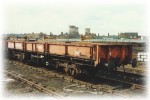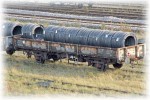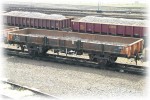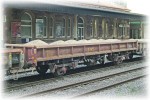| << Profile 31 >> |
SPA Plate Wagons |
| Build Details: |
Converted 1977 BR Ashford, new builds 1979-1981 BR Shildon |
| Numbering: |
460000-461101 |
| Bogies / Suspension: |
|
| Dimensions: |
11490mm LOB , 6320mm wheelbase |
| Published Drawings: |
Rolling Stock Recognition:2 - BR and Private Owner Wagons (Ian Allan, 1984). NB. Drawings of OCA and SPA were transposed. |
| Areas of operation: |
Nationwide |
| Main liveries: |
Railfreight red, Civil Engineers grey/yellow, EWS maroon |
| Summary: |
Following the conversion of two SAA steel wagons into SPA plate wagons in 1977, a production run of 1100 new-build SPAs was authorised. Further batches totalling 600 wagons were cancelled before work started. Although designated as a steel plate carrier, the type found a wide variety of uses including loads as diverse as army vehicles and rod coil. As with many of the air-braked types, there have been many subsequent modifications, both for revenue and departmental uses. |
|
| History: |
Following the conversion of two SAA steel wagons into SPA plate wagons in 1977, a production run of 1100 new-build SPAs was authorised. Further batches totalling 600 wagons were cancelled before work started. Although designated as a steel plate carrier, the type found a wide variety of uses including loads as diverse as army vehicles and rod coil. As with many of the air-braked types, there have been many subsequent modifications, both for revenue and departmental uses.
The two prototype SPAs (460000/460001) were converted from SAA wagons 400100 and 400142 at Ashford Works in 1977. Lot number 3914 and design code SP019A were allocated. As rebuilt, the wagons had fixed steel ends and four drop-side doors on each side with prominent door stops and bangers. Livery was bauxite, these being the only SPAs to carry this. The pair did not remain as SPAs for long, being recoded to RBA for use as barriers in 1981. Both were later transferred to the research department and given RDC prefixes. RDC460000 was recoded ZXQ and was modified with a curious-looking superstructure for use as part of the structure gauging train. RDC460001 returned to the revenue fleet in 1985 and was recoded FPA for conversion to a container wagon. It was quite soon further recoded as an RBA barrier, then to RRA by 1989 and finally withdrawn in the early 2000s.
The first production SPAs were 600 built at Shildon works in 1979-1980 to lot number 3839 and numbered 460002-460601. The lot number is curious in being lower than that used for the prototype conversions some 2 years earlier. Other lot numbers in the same range relate to vehicles built in 1973/1974 so it would appear that lot 3839 was either changed or put on hold for some reason. The prototype SPAs were to design code SP020A and differed from the prototypes in several ways. The number of drop-side doors was reduced to 3 per side, the doors themselves were simpler in appearance, the door-bangers were replaced by control springs, the solebars were straight (as opposed to shallower over the axleguards), and the livery was Railfreight red. Compared to the vacuum-braked plate wagons built in large numbers prior to 1961, the SPAs had sturdier and taller bodywork, while the original plate wagons had just 2 doors per side.
A second batch to the same design code was built in 1980/1981, again at Shildon. Lot number 3962 was originally for 900 wagons but the last 400 (intended to have been numbered 461102-461501) were cancelled before being built. Two further lot numbers were allocated to SPAs but not in the event used. Lot 3995 was for 100 wagons numbered 461502-461601 to have been converted from surplus SAAs, while lot 3988 was for 461602-461701 to design code SP020A and presumably therefore new-builds.
Despite being in fairly general use, it soon became evident that there was a surplus of SPAs and most of the first 330 wagons (460002-460331 range) were transferred to departmental use in 1983. These were recoded ZAA to design code ZA008A, and the numbers gained a DC prefix. The fishkind name of Pike was allocated to these unmodified wagons. 40 further SPAs became ZAAs to design code ZA013A with ADC prefixes as part of the CM&EE fleet. Other conversions affected wagons remaining in the revenue fleet. At least 40 SPAs were fitted with cradles to carry coils (28 by 1985), while some others were modified to carry pig iron. Neither of these changes resulted in TOPS code or design code alterations. However, 50 SPAs were recoded as KOAs in 1983 following modification to 'Coil O's to carry rod coil from Allied Steel at Cardiff. The conversion involved the removal of the sides and the fitting of curb rail and wooden saddle to carry coils of steel rod. At about the same time, 35 SPAs became KTA 'Strip Coil T' wagons, carrying three rolls of strip coil and retaining the original bodywork. In the TOPS code reshuffle of 1983 these two types became SKA and SHA respectively.
TOPS code SDA was issued in 1984 to cover the modification of SPAs into bolster wagons. This entailed the removal of the wagon sides (but not the ends) and the fitting of three bolsters with removable stanchions. One wagon (460563) was converted in 1984 but not recoded until it was joined by 29 others in late 1986, these being for the movement of steel slabs from Scunthorpe to Rotherham. In April 1987 the revenue fleet of SPA derivatives totalled 737 (30 SDA, 35 SHA, 50 SKA and 622 SPA)
One further modification in the 1980s was the fitting of a flexible hood to protect loads of steel rod coil. The blue hoods carried Railfreight Metals lettering plus the logo of main customer Allied Steel and Wire (Cardiff). 460619 was so modified by 1988 and new TOPS code SEA was issued in 1989. A total of 20 were in service by the beginning of 1990, rising to 35 by 1991. 1989 also saw further SKAs converted.
Many of the former SPAs in departmental use had been repainted in the civil engineers livery of grey and yellow during the 1980s but the type was not proving ideal. The dropsides were easily damaged when loading and unloading ballast or spoil. In 1990, 75 of the ZAA fleet were recoded to ZCA with design code ZC010A and the new fishkind name of Seahare. The conversions were carried out at York Wagon Works and involved strengthening the sides and welding the doors shut. The departmental fleet was increased by further transfers during the early 1990s to codes ZAA and ZDA. The source wagons included former SHA and SKAs as well as SPAs and some were allocated to the Signal & Telegraph Engineers (KDC prefix) and Electrification Projects (LDC prefix). The revenue fleet was affected by the first condemnations, either for scrapping or sale to other users. At the start of 1992 the fleet stood at 645 wagons (30 SDA, 35 SEA, 30 SHA, 59 SKA and 491 SPA). The SHAs were being used from Ravenscraig Steel Works, the closure of which rendered them surplus. A few found alternate uses (as runners or carrying waste and packing) while others reverted to SPA or were transferred to the departmental fleet. The transfers were joined by more ex SPAs to produce ZCA Seahares for use by the Civil Engineer, Network SouthEast. A total of 200 such wagons was planned
A new TOPS code to appear on this type was ZXA, this being applied to two former ZAAs in 1993 when they were modified as relaying equipment carriers. With transfers to ZCA Seahares continuing, the revenue fleet was down to 388 wagons by the start of 1994, comprising 30 SDA, 35 SEA, 6 SHA, 40 SKA and 277 SPA. When Railfreight was split into three regional companies in 1994, the revenue fleet was divided between the North (later Loadhaul) and West (later Transrail) fleets, the exception being 30 SKAs which went to the South East (later Mainline) company. Five ZAAs were modified in 1995 for use with Plasser & Theurer Balllast Distribution trains. Most of the bodywork was removed and a support for the ballast conveyor added to one end. In 1997 60 SPAs (including some former ZAA and ZCA wagons) were modified at Adtranz, Crewe into ZCA Sea Urchin ballast wagons. This type had been in service in large numbers since the early 1990s but previous conversions had been from OBA opens or VAA/VBA/VDA vans. The new rebuilds retained the existing ends but featured new, fixed sides with substantial side ribbing and angled tops to prevent the accumulation of spilled ballast. The wagons were finished in EWS maroon with yellow top capping. Other conversions in the same year were of more SKAs, Thornaby depot fitting triple coil cradles from BZA wagons to redundant SPAs. Under EWS ownership, many of the unmodified ZAA wagons were recoded SPA in line with a new common owner pooling policy. This resulted in the revenue fleet rising to 457 by 1998, made up of 30 SDA, 35 SEA, 6 SHA, 48 SKA and 338 SPA. Of note is that, apart from the ex-private owner scrap wagons coded SSA, these 5 types were the only Sxx TOPS codes still in use. A final code addition took place in 1999 when about 15 of the SKAs were recoded SCA for use between Seaforth and Panteg.
More ZCA Sea Urchin conversions took place in 2000, this time at Wabtec, Doncaster. The fleet of such wagons then stood at 99 but more were to follow. Otherwise, the first decade of the 21st century saw only condemnations and by the end of 2005 the entire SPA fleet had been reduced to 681. 481 were still coded for revenue use (15 SCA, 30 SDA, 25 SEA, 1 SHA, 9 SKA and 401 SPA) while the departmental fleet accounted for 200 (10 ZAA Pike, 184 ZCA Seahare/Sea Urchin, 4 ZXA and 1 ZXQ gauging car plus 1 reported as a ZDB, vacuum-piped general materials wagon). Some of the SEA wagons had had their hoods removed but were still recognisable by the runners fitted to the top of the sides. While some of the SPAs retained Railfreight red livery (often looking very battered) others had been repainted in Transrail grey, EWS maroon and even Network Rail yellow. |
|
| Queries: |
|
|
| References: |
|
|
| Links: |
 PDF version of this profile (Right click and select Save Target As to save (453KB)) PDF version of this profile (Right click and select Save Target As to save (453KB))
Photos of SPA wagons on Paul Bartlett's website
Photos of modified SPA wagons (including SDA, SEA, SHA, KOA) on Paul Bartlett's website
Photos of SPA wagons in departmental use (as ZAA and ZCA) on Paul Bartlett's website
Photos of SPA wagons on Martyn Read's website
Photos of SDA conversions on Martyn Read's website
Photos of SEA conversions on Martyn Read's website
Photos of ZCA Seahare conversions on Martyn Read's website
Photos of SPA wagons on Andy Jupe's website
Photos of SDA wagons on Andy Jupe's website
Photos of SEA wagons on Andy Jupe's website
|
|
| Updates: |
15/03/2013: Photo links (finally) updated.
|
|
| Photos |
| For more pictures see the Links section at the bottom |

Prototype SPA 460001 running as an RBA, Stanlow, 27th June 1981.
Paul Bartlett

Brand new SPA 460759 at Shildon, 6th April 1980. It is loaded with another new SPA, not yet lettered and awaiting wheelsets.
Paul Bartlett

ZAA (ex SPA) DC460315 at Willesden, 29th March 1987.
Tom Young

SHA conversion 460726 at Severn Tunnel Junction, 29th May 1985.
Paul Bartlett

SKA conversion 460659 at Brierley Hill, 29th March 1989.
Paul Bartlett

SDA conversion 460920 at Rotherham, 26th February 1989.
Paul Bartlett

SEA conversion 461005 at Cardiff Tidal, 30th September 1990.
Paul Bartlett

SPA 460250 (ex ZAA) in Civil Engineers livery with a typical load of rod coil. Tees Yard, 5th October 2007.
Martyn Read

ZCA Seahare conversion 460165 in Loadhaul livery at Rugby, 21st April 2005.
Martyn Read

ZCA Sea Urchin conversion 460503 at Newport, 21st August 2007.
Martyn Read
|
|















